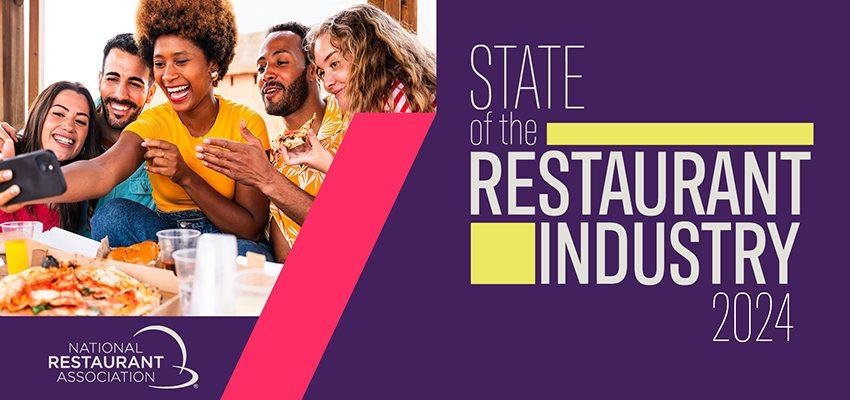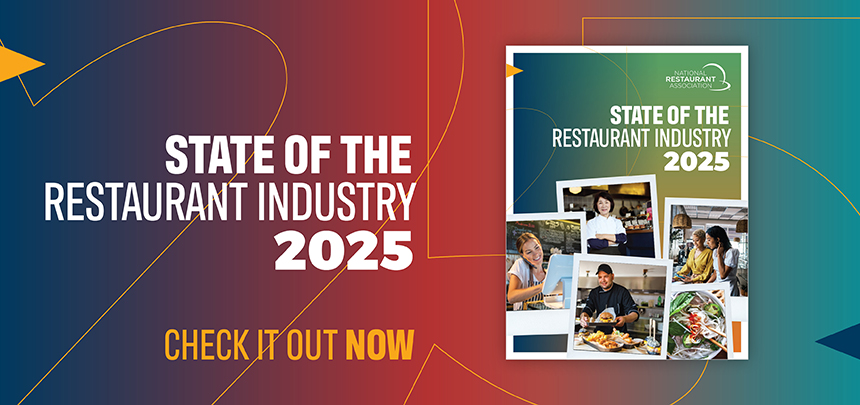Articles
February 08, 2024
The state of the restaurant industry is positive
Tech, off-premises business help drive $1.1T in sales.

According to the Association’s 2024 State of the Restaurant Industry report, customers say their desire to use restaurants is as strong as ever after living through a pandemic and years of economic uncertainty.
Now, projections indicate total restaurant sales could exceed $1.1 trillion in 2024, if the economy continues to be strong and unemployment—currently at 3.7%—stays low.
In a recent Q&A, Hudson Riehle, senior vice president of Research and Knowledge for the National Restaurant Association, talked about what the industry can expect. An increase in the use of technology, expansion of off-premises services, and ways to confront labor challenges will be top of mind, he says.
What is the state of the restaurant industry in 2024?
Restaurants will remain a priority for consumers—they consider restaurants essential to their lifestyles—and the industry will remain a cornerstone of the national economy, employment, and communities. And though sales are forecast to exceed $1.1 trillion, restaurateurs remain uncertain about profitability, given the impact of highly elevated food, labor and operating costs.
What does the employment picture look like for 2024?
Operators report recruitment and higher wages remain their top challenges. In California, for example, wages are $20 an hour, so operators are trying to figure out how to re-engineer their operations because they aren't designed to function with these disproportionately high labor costs. 2024 will be somewhat better than 2022 and 2023, but wages won’t be going back to what they were pre-pandemic.
It's also important to understand the role gig workers could play in the industry. There’s a growing opportunity to employ these individuals in restaurants because of the way the industry’s workforce is structured and used. The technology's there. A gig worker can scroll through his or her smartphone for a list of jobs at the beginning of the day and decide which restaurant they wish to work at. A quarter of operators report they think the use of gig workers will increase in their segment in 2024.
This year’s report gauged consumers’ views on the use of technology at restaurants. What did the Association find?
Acceptance and desire for more technology varies dramatically between tableservice, quickservice, and off-premises occasions, both in how its applied and by the age group of respondents. Tech-enabled transactions are widely accepted by all age groups for off-premises transactions, much more so than in fullservice and quickservice transactions. And overall, younger generation respondents are much more accepting of technology in their restaurant experiences.
The report shows that loyalty apps are gaining importance. Why?
Association research finds that consumers are more value-conscious than ever. The idea of earning points towards meals, qualifying for discounts and free food and beverage items, which many of the programs offer, is highly attractive. It’s so attractive that consumers report they’d choose a restaurant where they can earn loyalty points over another restaurant even if the latter restaurant was more convenient. Currently, the expansion of loyalty programs is one of the most important developments regarding restaurant value propositions. The technology is rapidly advancing; restaurants can reward customers for their support in real time.
Where does third-party delivery stand in 2024?
It’s certainly opened up new options regarding the manner in which consumers make their dining choices, and enhances their convenience for receiving restaurant prepared meals, snacks and beverages. The fact is third-party delivery services are here to stay.
The report also touches on the meal blending trend. Why is it so popular?
Meal blending really allows the consumer to use restaurants’ off-premises options as part of the standard at-home meal occasion. It’s becoming especially popular among Gen Zs and millennials because it supplements their home-cooked meals with restaurant food.
Download your copy of the 2024 State of the Restaurant Industry report today!
Now, projections indicate total restaurant sales could exceed $1.1 trillion in 2024, if the economy continues to be strong and unemployment—currently at 3.7%—stays low.
In a recent Q&A, Hudson Riehle, senior vice president of Research and Knowledge for the National Restaurant Association, talked about what the industry can expect. An increase in the use of technology, expansion of off-premises services, and ways to confront labor challenges will be top of mind, he says.
What is the state of the restaurant industry in 2024?
Restaurants will remain a priority for consumers—they consider restaurants essential to their lifestyles—and the industry will remain a cornerstone of the national economy, employment, and communities. And though sales are forecast to exceed $1.1 trillion, restaurateurs remain uncertain about profitability, given the impact of highly elevated food, labor and operating costs.
What does the employment picture look like for 2024?
Operators report recruitment and higher wages remain their top challenges. In California, for example, wages are $20 an hour, so operators are trying to figure out how to re-engineer their operations because they aren't designed to function with these disproportionately high labor costs. 2024 will be somewhat better than 2022 and 2023, but wages won’t be going back to what they were pre-pandemic.
It's also important to understand the role gig workers could play in the industry. There’s a growing opportunity to employ these individuals in restaurants because of the way the industry’s workforce is structured and used. The technology's there. A gig worker can scroll through his or her smartphone for a list of jobs at the beginning of the day and decide which restaurant they wish to work at. A quarter of operators report they think the use of gig workers will increase in their segment in 2024.
This year’s report gauged consumers’ views on the use of technology at restaurants. What did the Association find?
Acceptance and desire for more technology varies dramatically between tableservice, quickservice, and off-premises occasions, both in how its applied and by the age group of respondents. Tech-enabled transactions are widely accepted by all age groups for off-premises transactions, much more so than in fullservice and quickservice transactions. And overall, younger generation respondents are much more accepting of technology in their restaurant experiences.
The report shows that loyalty apps are gaining importance. Why?
Association research finds that consumers are more value-conscious than ever. The idea of earning points towards meals, qualifying for discounts and free food and beverage items, which many of the programs offer, is highly attractive. It’s so attractive that consumers report they’d choose a restaurant where they can earn loyalty points over another restaurant even if the latter restaurant was more convenient. Currently, the expansion of loyalty programs is one of the most important developments regarding restaurant value propositions. The technology is rapidly advancing; restaurants can reward customers for their support in real time.
Where does third-party delivery stand in 2024?
It’s certainly opened up new options regarding the manner in which consumers make their dining choices, and enhances their convenience for receiving restaurant prepared meals, snacks and beverages. The fact is third-party delivery services are here to stay.
The report also touches on the meal blending trend. Why is it so popular?
Meal blending really allows the consumer to use restaurants’ off-premises options as part of the standard at-home meal occasion. It’s becoming especially popular among Gen Zs and millennials because it supplements their home-cooked meals with restaurant food.
Download your copy of the 2024 State of the Restaurant Industry report today!
Supported by
-
SageSage Intacct accounting software delivers exceptional customer experiences while driving revenue and growth. Built in the cloud for the cloud, Sage Intacct digitizes business processes, improving operational efficiency and profitability. Restaurant operators of all sizes depend on Sage Intact for exceptional visibility into their financial performance.Learn more
Get the report
Get the report
Sign up for our Newsletter
The latest news from the National Restaurant Association, published every other Thursday
By clicking Submit I agree to receive email communications from the National Restaurant Association and agree to our Privacy Policy(Opens in a new window).

